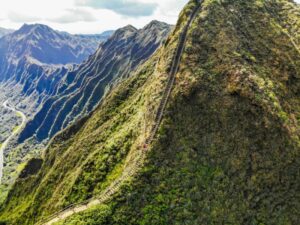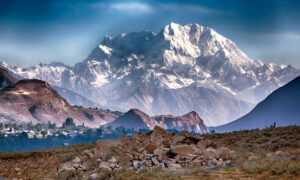A rescue mission on a dangerous peak. Inexperienced climbers who didn’t belong. Snow softening in the heat of the day. And then, the accident.
BY KONSTANTIN MARKEVICH
I knew Valya Mikhailov for a little less than half a year. At the end of March, he wrote to me and suggested we do something together. I did not yet have plans for the season and I agreed.
At first, we wanted to combine some technical routes with altitude. Then we decided that there was no point in this, and if we were going to high mountains, then we should try to do as much as possible. We planned to go to Lenin Peak, then to Khan Tengri, then Pobeda.
We trained and prepared. Valya worked out two or three times a day. At the end of June, he left to work as an instructor at an alpine club’s training camp in Bezengi. Then he went to Elbrus, slept at 5,000m.
On July 14, we met in Osh, Kyrgyzstan. On July 25, we climbed 7,134m Lenin Peak in the Pamirs. Then we flew to Bishkek and rested. On August 1, we took a helicopter to the South Inylchek Glacier in the Tien Shan.
The weather at Base Camp was perfect, not a cloud in the sky. We decide that we needed to climb immediately, especially since we were well-acclimatized after Lenin Peak. Let’s have lunch, start…
Fast work on Khan Tengri
The plan worked, and a day later at lunchtime, we were at the top of Khan Tengri!
On August 4, we descended back down to Base Camp. I felt good, Valya was tired. We decided to rest for a few days before trying Pobeda. And then suddenly, I saw my old friend, Sasha Ivanov. He is from St. Petersburg and we often meet in different places, either in the mountains or at climbing competitions.
He told me that there were problems.
Another group of Russian climbers on Pobeda has lost contact. Led by Igor Viskov, these are experienced guys. Most likely, they just lost their walkie-talkie. That turned out to be the case, but we didn’t know it at the time. But their route followed a big and dangerous wall, so anything might have happened. It was at least necessary to go there and assess the situation.

Pobeda Peak. Left, Abalakov route. Right, Classic route. Photo: Markus Gschwendt
The rescue
But a less experienced group from St. Petersburg led by Alexandra (Sasha) Moroshkina had got into trouble on Abalakov route. They fell and were flying down the slope when a crack miraculously arrested their slide. They spoke of quite serious injuries, and while they were able to walk on their own, they asked for help. Three Russian friends of ours on the same route, including Nikolai Totmyanin and Alexander Dusheiko, managed to pull them out of this crack and slowly lowered them down.
Valya and I believed that the injured climbers still needed help. Our three friends were not enough to help them down. So seven of us went up: Sasha Ivanov, Artur Matinyan, Vitya Trikozov, Nastya Petrova, Nadya Muzhikina, Valya Mikhailov, and I.
Even this might not be enough, but we wanted to help in any way we could. We put off our own plans, and on August 7, we left the camp early in the morning. We took with us about 400m of rope to fix tricky sections with, to speed up the descent of the victims, and to help convey up food and medicine.
On the way, we met Igor Viskov’s group. As suspected, they had lost their radio. A powder avalanche had hit them overnight, battering their tent and covering them with snow dust, but they were okay. They continued down. One less concern for us.
In the evening we reached the top of the “pedestal” (5,200m) and set up camp there for the night.
The plan
Our plan was as follows: At 5 am, Valya Mikhailov, Trikozov, and I went up to meet the ailing climbers. We took medicine and 150m of rope. We planned to give them medicine to combat altitude sickness and help carry their heavy backpacks.
Meanwhile, Ivanov and Matinyan went down to fix the steep sections of the pedestal with what rope we had. Where there wasn’t enough rope, they prepared rappel stations. Nastya Petrova and Nadya Muzhikina waited in camp.
In the morning, we left as planned and walked along a snowfield and onto the ridge. At first, it was gentle, then there was a steep section. In the upper part of this section, we buried a bag of snow, made a rappel station, and left 100m of rope.
Then a section with cornices began. It was 100m long and ended at a rocky wall, under which we would meet the victims. The altitude was already about 5,650m. The cornices were steep but looked reliable. The site itself was rather gentle, in some places almost horizontal.
We went along the trail where three groups had passed before us. Sasha Dusheiko asked on the radio to hang a rope on the rock wall. I didn’t really understand this request, because they just needed to make a station and go down, and we needed to climb.
Valya Mikhailov climbed and dug out a rappel station with his shovel and began to descend. One of the climbers, Natasha Beliankina, tied into the station. Valya reached the middle of the wall when the station broke away. Instinctively, they slid on opposite sides of the ridge. Valya crawled out to us, Natasha waited until Nikolai Totmyanin made a secure belay station. Then she also came down to us. Obviously, the station was bad, so it broke away. Not a good situation, but nothing terrible happened.
Surely a novice wouldn’t be on Pobeda?
Beliankina and Totmyanin descended, followed by the victims. First Ilya Solovyov. He took forever. It looked weird, as if it was the first time for him. But this was Pobeda Peak. Surely it wasn’t possible for a novice to be here.
I blamed his awkwardness on injury, shock, and fatigue. Then Sasha Moroshkina, and one more. There was a comfortable platform under this wall. It even looked like someone could spend the night there.
Valya took Moroshkina’s backpack from her and walked a little lower with Sviatoslav Kornev, to the station from which we’d planned a rappel.
I never saw Valya again.

The site of Mikhailov’s accident, before and after. Photos: Konstantin Markevich
The cornice collapsed in the heat of the day
I was waiting slightly above for one of the climbers who needed an injection for altitude sickness. All the others, by the way, refused injections. Generally, they looked much better than we had imagined they would.
At some point, someone said that the cornice collapsed. At first, I did not attach much importance to this. Then I realized that a huge block had fallen away. Sviatoslav Kornev sat at the station from which we’d planned the rappel. Confused at first, I thought that Valya was rappelling down and untangling the rope.
But when I approached this station, I saw that the rope was on the backpack. Valya was gone. I went to where the cornice broke away and looked down. The ice couloir went down, down, past rocks to the glacier 800m away. No one could survive that fall.
I reported the accident on the radio.
Another strange incident
We continued down, but my suspicion of the climbers in our charge grew. During the descent, Matinyan and Trikozov worked first, and Ivanov and I closed the rear.
At one point, we had to pass the rope down. This maneuver required Ilya Solovyov to re-tie his knot. I passed him the end of the rope and…it turned out that he did not know how to tie a figure 8. On Pobeda. On an extremely complex route.
From that moment, I couldn’t help think that their climb was some sort of idiotic scam and that the failure was far from an accident. Solovyov’s lapse shocked me even more than the cornice breaking away.
However, we promptly lowered the victims another 800m down, thanks to Ivanov and Matinyan’s stellar rope fixing. By evening, everyone was on the glacier.

A close-up of the broken cornice. Photo: Konstantin Markevich
Would a rope have saved him?
At the time of the fall, Valya was unroped. Over the past 10 days, I have thought a lot about what would have happened if he had been roped up. And I believe that with the layout of that ridge, and the cornices, it is most likely that the whole roped line of people would have fallen through.
I believe that the cause of the accident was a long stay in a dangerously corniced area during the warm part of the day. You need to pass such places as quickly as possible, at 5 am. We spent 3.5 hours there, from 9 am to 12:30 pm. In such a situation, maybe you will be lucky, maybe not.
On the day of the accident, Igor Viskov, Sergey Seryanov, Ilya Penyaev, and Pasha Fominykh went out to search for Valya. They examined the glacier slopes and the wall but found nothing. On August 10, not without difficulty, I managed to fly over the area and photograph it. Perhaps we’ll be able to see something in these photos later. But it doesn’t really matter anymore.
It was incredibly disgusting to listen to [Sasha] Moroshkina whine that entire day that she had lost all her things, and why the hell did “this boy fly away with [her] backpack”.
Dear Sasha: The “boy” was 43 years old. He has two children, a wife, and elderly parents.
Rescues are voluntary and dangerous — Pobeda triply so
He took your backpack because you told us on the radio how shitty you felt. And no one would have fallen if you had properly judged your strength and experience. I’m not accusing anyone of anything. Taking part in a rescue is voluntary and dangerous. Taking part in a rescue on Pobeda is triply dangerous. But all events have a cause.
If you descend at night with two headlamps for four people, then someone can fall. If the veteran climbers you consult advise against taking this route, then it makes sense to listen. And especially, if a person without mountaineering experience attempts such a climb, expect trouble.
And of course, there was Ilya Solovyov. Once in Base Camp, he began to puff out his cheeks and brag how he conquered Pobeda.
I wanted to hit him, but I somehow restrained myself.
This article first appeared in Russian, on mountain.ru.






